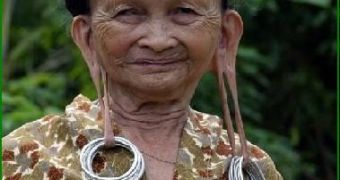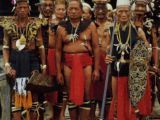1.The populations of Indonesia, Malaysia, Philippines and other parts of the southeastern Asia are called Malayan. These people originated in a migration of Mongoloid tribes coming from Taiwan. They first entered Philippines and from there colonized the whole Pacific and Indonesia. But before the Austronesian migration, the whole southeastern Asia was inhabited by Black people belonging to the so-called Black Asian race, now surviving in New Guinea and Melanesia. Pygmies seem to belong to this race, and even today, tribes of pygmies, called negritos, survive in the remote mountains of Philippines. The first Austronesian wave, at least 5,000 years old, is formed by Proto-Malayans, farming people of average height, darker skin and black hair. A second Austronesian wave, about 2,000 years old, came from Indochina. These are called Deutero-Malayans, have a high degree of civilization and occupy usually the coasts of the islands, being good fishermen and sailors.
The Dayak people represent a group of Proto-Malayans inhabiting the inner part of Borneo (the largest Indonesian island). They are related with the Batak of northern Sumatra, Igorrote of Philippines, and various tribes of Timor, Celebes, Sumatra and Moluccas. During their history, the Dayaks experienced many external influences, especially of Hinduism, a religion that many ethnic groups of Borneo converted to. Still, Dayaks are highly conservative, and each village is organized in clans composed of various families that admit the authority of a sole chief; this structure allows a tight collaboration in field labor and other collective works. During the harvesting period, festivities accompanied by dances are kept.
2.Dayaks usually make their villages on the banks of the rivers and lakes. They make branch huts. The large houses are destined to host a whole clan. A large house looks like a gallery covered by a two-plane roof and raised over wood posts. Sometimes, these houses can be 200 m (660 ft) long. The whole clan works to make these houses built from trunks, bamboo, branches and leaves. Their interior is divided in compartments destined for the life in common of the men, workshop for crafts and shelters for each family.
3.Dayaks worship a superhuman power, called semangat, that rules the lives of humans, animals and plants. This invisible life force dwells many places: all the human body parts, cut hair, shadows, names, the water in which a human or animal bathed, traces imprinted in the mud... Semangat can enter any body, and it is somehow like a soul that can be destroyed by other more powerful souls. The soul of any man is inherited from a forebear, that's why the cult for the forebears is crucial. Wooden carvings are supposed to host the souls of the dead. All the souls submit to two divine powers: the sky, whose image is the hornbill bird, and the land with water, symbolized by the infernal snake.
4.Like all Proto-Malayans, Dayaks are a mix between Mongoloids and Asian Blacks, with the predominant genetic background being Mongoloid (the situation is inverse on the coast of New Guinea or Melanesia). Their nose is flattened, the lips are thick and the eyes are somehow almond-shaped, but less than in the case of pure-blooded Mongoloids. Dayaks, both men and women, are famous for their heavy metal rings worn as earrings, that deform their ear lobes.
5.Men are assigned to four classes: children, teenagers, young men and old men. Each class has specific tasks. Young men are before all warriors that have to defend the village against neighboring tribes. When defeating the enemy, Dayaks beheaded them and preserved their heads as trophies in the communal houses. That's why they inspired dread amongst other people, being famous as "head-hunters".
Dayak, both men and women, wore just a short skirt of fabric reaching the knees and a type of cylindric biretta, made of twisted palm leaves and often adorned with glass beads or sea snail shells. Women also adorn with collars made of animal teeth, insect wings, mother-of-pearl pieces, feather dressing and metal bracelets. The husband can belong to the same tribe or clan or even to a neighboring tribe; only marriages inside the same family are forbidden. Sons inherit the name of the father, charged with teaching them the moral principles of the Dayak life.
6.Dayaks use machetes during their journeys through the jungle. They use blowpipes and envenomed darts for hunting small game and birds. Only Proto-Malayans and some tribes of Amazonia are known to use this weapon.
The main Dayak crops are millet, rice, sugar cane, tobacco (introduced in the 16th century), areca palms (from their fruits, they make an alcoholic beverage), and betel, its leaves being collected by women. Betel leaves, together with areca nuts (Areca catechu), previously crushed, made the betel nuts, consumed the way Andean Indigenous people consume coca. Betel leaves were preserved in wooden recipients filled with limestone. The chewing of the betel nuts colored the lips and the saliva in a vivid red and produced stimulant effects. From Indonesia, betel consume expanded to Indochina and India.
Dayaks collect rubber from the rubber fig tree (Ficus elastica). They exchanged rubber on the coastal areas for tools, farm equipment, seeds and western products.
Dayak fishermen used canoes made of wood boards, joined by resins or rubber for a total impermeability. These people used reds, fishing baskets or wood barrels with a funnel-shaped orifice.

 14 DAY TRIAL //
14 DAY TRIAL // 
